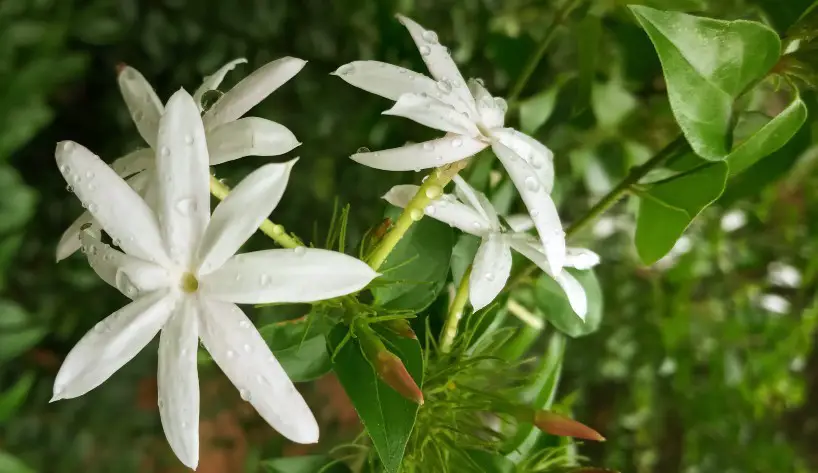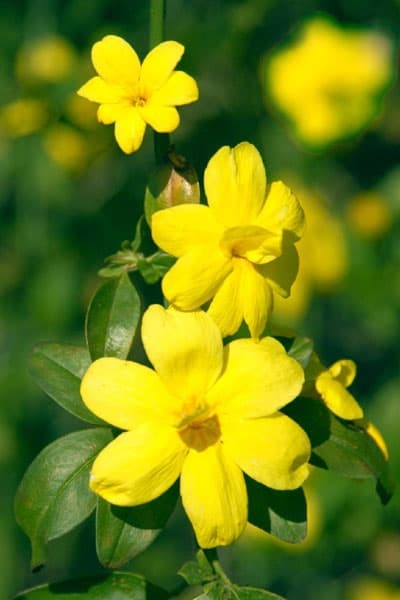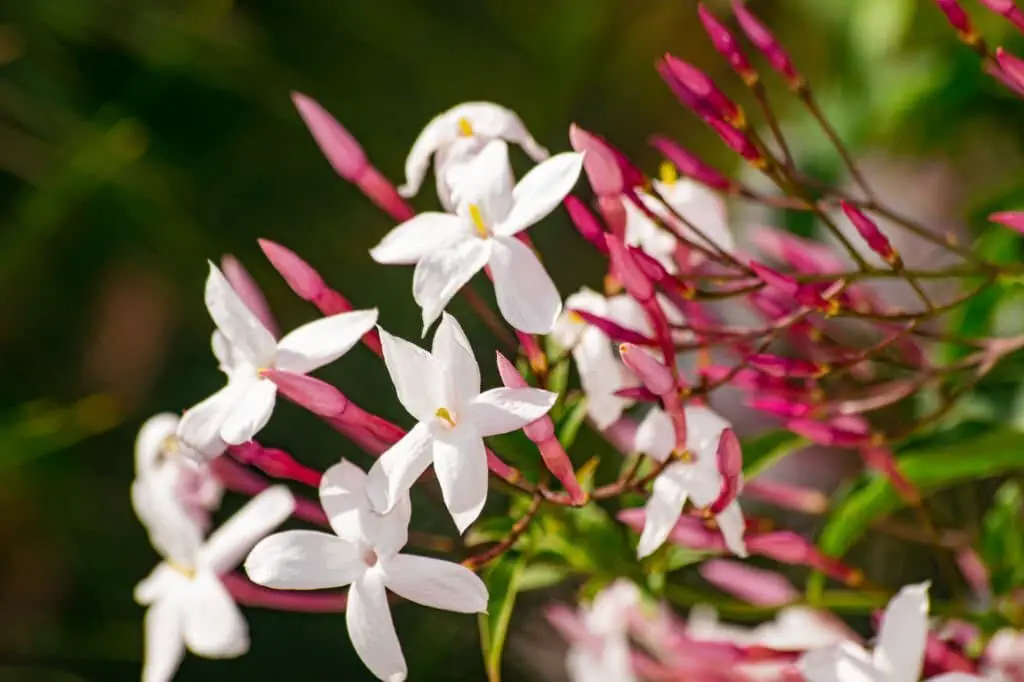18 Different Types Of Jasmine Flowers: A Comprehensive Guide
Jasmine flowers are a delight to behold, with their sweet fragrance and delicate beauty. With over 20 different types of jasmine flowers, each one has its unique characteristics and benefits. In this blog post, we’ll delve into the most common varieties, exploring their distinct features and how to care for these lovely plants.
From the Angel Wing Jasmine to the Winter Jasmine, we’ll cover the likes of Arabian Jasmine, Asian Star jasmine, Cape Jasmine, Common jasmine, Downy Jasmine, Dwarf Jasmine, Forest Jasmine, Italian Jasmine, Lemon-Scented Jasmine, Night-Blooming Jasmine, Pink Jasmine, Primrose jasmine or Japanese jasmine, Royal Jasmine, Showy jasmine, Spanish jasmine, and Wild Jasmine.
Whether you’re a seasoned gardener or just starting out, this article will provide valuable insights into the world of jasmine flowers.
Angel Wing Jasmine (Jasminum nitidum)

Angel Wing Jasmine (Jasminum nitidum) is an evergreen climber native to China, India, Nepal, Pakistan, and Vietnam. Its dark green, glossy leaves are a stunning feature, while the small white flowers with a potent fragrance bloom in clusters. This fast-growing plant can reach up to 20 feet tall, thriving in full sun to partial shade and well-drained soil. Notably, it’s also drought-tolerant once established.
Propagation is typically done through cuttings or layering in spring, although care must be taken as the plant is susceptible to root rot if the soil isn’t well-drained. Despite these requirements, Angel Wing Jasmine is an excellent choice for those seeking a fragrant and rapid-growing climber. Its resilience makes it perfect for hot, dry spots in your garden, adding a touch of sophistication to any landscape.
Arabian Jasmine (Jasminum Sambac)

Jasminum sambac, commonly referred to as Arabian jasmine or Sambac jasmine, is a member of the Oleaceae family and native to India and Sri Lanka. This versatile plant thrives in a range of environments, from full sun to partial shade, with moderate water requirements. The blooming period typically spans spring and summer, with delicate white flowers adorning its stems.
As an ornamental plant, Jasminum sambac is widely cultivated for its attractive blooms, which are often used in the production of perfumes. Its climbing and trailing abilities allow it to grow up to 15 feet or more, making it a popular choice for gardeners seeking to add vertical interest. The leaves are simple, opposite, and elliptical in shape, ranging from 0.75 to 12 cm in length and width. The plant’s flowers appear in clusters along the stems, with each bloom measuring approximately 0.
75 cm in diameter. Following the blooming period, Jasminum sambac produces black berries, each about 0.75 cm in size. This adaptable species is an excellent addition to any garden or landscaping project seeking a touch of elegance and fragrance.
Asian Star jasmine (Trachelospermum asiaticum)

The Asian Star Jasmine (Trachelospermum asiaticum) is a tropical to sub-tropical evergreen vine that thrives in a variety of conditions. Native to China and Japan, this versatile plant is ideal for those seeking a fast-growing groundcover or a solution to quickly cover an unsightly fence or structure. With regular pruning, mature plants can reach up to 15 feet in length, making it a popular choice for topiary and ornamental displays.
The small, white, star-shaped flowers bloom throughout the summer and fall seasons, emitting a light, sweet fragrance that adds to their charm. Asian Star Jasmine is remarkably resilient, tolerating a wide range of soil types and preferring full sun to partial shade. Once established, it can also withstand drought conditions. This hardy vine can be easily propagated through stem cuttings taken in the spring or summer, making it an excellent choice for gardeners of all levels.
Cape Jasmine (Gardenia Jasminoides)

Gardenia jasminoides, commonly referred to as Cape jasmine or gardenia, is a stunning evergreen shrub that boasts glossy, dark green leaves and exquisite white flowers with a sweet fragrance. Native to China and Japan, this plant has been successfully introduced to various regions around the world. Its ornamental value is undeniable, and it also finds use in traditional Chinese medicine.
In terms of its growth habits, Cape jasmine thrives in well-lit conditions, ranging from full sun to partial shade, and prefers soil that drains efficiently. As a drought-tolerant plant, it can be grown in a variety of climates. While relatively low-maintenance, Cape jasmine is not entirely immune to pests and diseases; however, with proper care, it remains a popular choice for gardeners and horticulturists alike.
Common jasmine (Jasminum officinale)

Common jasmine (Jasminum officinale) is a prolific twining vine that can rapidly grow up to 15 feet or more within a single season, with its climbing abilities making it an ideal addition to any garden. With a hardiness zone rating of USDA 7, this species thrives in temperate climates.
Originating from Western and Central Asia, where it’s native to the Caucasus region, Iran, and as far west as Pakistan’s Indus Valley, jasmine has been cultivated across various countries including China, India, Pakistan, and Morocco. The plant’s striking features include its white flowers with a strong sweet fragrance, ovate-acute leaves that are glossy dark green on top and pale green underneath, and a ripened red berry.
As one of Linnaeus’ original species descriptions in 1753, Jasminum officinale remains an iconic and fascinating specimen in the botanical world.
Downy Jasmine (Jasminum pubescens)

The Downy Jasmine (Jasminum pubescens) is a twining vine characterized by dark green, opposite leaves. Its fragrant white flowers, comprising five petals and measuring approximately one-half inch across, bloom in late spring to early summer, followed by black berries. Native to China, this plant has been introduced to Europe and North America, often serving as an ornamental addition in gardens.
Preferring full sun but adaptable to part shade, the Downy Jasmine thrives in fertile, well-drained soil and demonstrates moderate water requirements. While drought-tolerant once established, it’s essential to consider local regulations regarding its potential invasiveness before planting. As such, consulting with your local cooperative extension office is recommended.
Dwarf Jasmine (Jasminum Parkeri)

Jasminum Parkerii, also known as Dwarf Jasmine, is an evergreen shrub that hails from China. This fast-growing plant can reach heights of up to 0.75 meters, boasting small ovate leaves and clusters of white star-shaped flowers that bloom in the summer and autumn months. Preferring full sun to partial shade, well-drained soil is also essential for its optimal growth. If you’re seeking a low-maintenance addition to your garden, Dwarf Jasmine is an excellent choice.
With minimal attention, it will flourish under regular watering and annual fertilization, making it an ideal option for busy gardeners.
Forest Jasmine (Jasminum abyssinicum)

Jasminum abyssinicum, also known as Abyssinian jasmine or East African jasmine, is a flowering plant that belongs to the olive family Oleaceae. Its native habitat includes Ethiopia, Kenya, and Somalia. This species of forest jasmine grows up to 15-20 meters tall, making it a notable presence in its natural environment.
Its leaves are arranged oppositely, taking on an ovate to lanceolate shape, measuring up to 12 centimeters in length and six centimeters in width.
The flowers are white, clustering together in groups of three to five. As for the fruit, it takes the form of a black berry, ripening during late summer or autumn.
The forest jasmine has multiple applications – it is cultivated as an ornamental plant, used in traditional medicine, and its essential oil is utilized in perfumery. This plant’s history of cultivation dates back to the early 19th century when it was first introduced to Europe.
It later made its way to North America in the late 19th century, eventually naturalizing in parts of the United States, Canada, and Mexico.
As a hardy plant, Jasminum abyssinicum is tolerant of varying climatic conditions. It thrives in full sun to partial shade and well-drained soil. Propagation can be achieved through seed or cuttings. Its adaptability has contributed to its widespread cultivation.
Italian Jasmine (Jasminum humile)

Jasminum humile, also known as Italian Jasmine, belongs to the Oleaceae family and is a species of jasmine. Its native range spans central and southern Europe, from France and Spain north to Austria and the Czech Republic. Additionally, it can be found in southwest Asia, extending from Turkey east to Iran.
This climbing shrub grows up to 2.5 meters tall, with twining stems that allow it to scramble or climb. The leaves are oval-shaped or oblong, measuring between 0.
75 and 12 centimeters long and 0.75-2.54 centimeters broad. They have a rounded tip and an entire or finely toothed edge.
Flowers are produced in clusters of two to seven, each featuring five petals fused at the base into a tube measuring about 3.5 millimeters in diameter. The tube is slightly shorter than the petals themselves, which are 3.5 millimeters long and have spreading lobes that release a sweet fragrance.
The flowering period typically occurs between June and September, while berries ripen to a blackish-purple color from October to November.
Lemon-Scented Jasmine (Jasminum azoricum)

The Azores native Jasminum azoricum, belonging to the Oleaceae family, boasts an impressive range as a popular ornamental in gardens globally. This twining vine can grow up to 16 feet in length, showcasing its glossy green leaves and clusters of small white flowers with a strong lemon fragrance. The plant’s blooming period spans late spring to early summer, making it relatively low-maintenance.
If you’re seeking to infuse your garden with beauty and an irresistible scent, the lemon-scented jasmine is an excellent option.
Night-Blooming Jasmine (Cestrum Nocturnum)

The night-blooming jasmine, scientifically known as Cestrum nocturnum, is a captivating shrub or small tree that can reach impressive heights of up to 15 feet (450 cm) and spread outwards by up to 12 feet (360 cm). Its origins lie in the Caribbean and Mexico, where it thrives in its natural habitat. One of the plant’s most striking features is its nocturnal flowering habit, with delicate white or greenish-white blooms that fill the night air with an intensely sweet fragrance.
While the scent is undeniably alluring, it’s essential to exercise caution when handling the plant, as ingesting any part can be toxic. If you’re looking to add a touch of enchantment to your garden, the night-blooming jasmine is certainly worth considering, but do keep in mind that its allure may prove irresistible to children and pets, so be sure to place it in an area where they won’t be tempted to investigate.
Pink Jasmine (Jasminum Polyanthum)

The pink jasmine, scientifically known as Jasminum polyanthum, belongs to the Oleaceae family and genus Jasminum. Within the order Lamiales, it is a species that originated from China but has since been widely cultivated in other parts of Asia, Europe, Australia, and the Americas. As a shrub or vine, the pink jasmine can grow up to 20 meters (66 feet) tall.
Characterized by opposite, evergreen leaves that are simple, ovate-lanceolate in shape, measuring between 0.75 to 11 centimeters (0.
30 to 0.43 inches) long and 0.25 to 17 centimeters (0.09 to 0.67 inches) wide.
The flowers of the pink jasmine are a notable feature, appearing in shades of white or pink with a diameter of approximately 15 millimeters (0.59 inches). The fruit, a black berry measuring about 20 millimeters (0.79 inches) long, is also notable for containing several seeds.
In addition to its ornamental value in gardens and parks, the pink jasmine is often used in the production of jasmine tea and oil, making it a popular choice among gardeners and enthusiasts alike.
Primrose jasmine or Japanese jasmine (Jasminum mesnyi)

Jasminum mesnyi, also known as primrose jasmine or Thai jasmine, belongs to the olive family Oleaceae and is classified under the genus Jasminum, order Lamiales, and species J. mesnyi. This flowering plant species is native to China, Japan, and Korea, where it thrives as a shrub or vine. Its most striking feature is its white flowers with five petals that exude a strong fragrance, typically blooming during the summer and autumn seasons.
Royal Jasmine (Jasminum Grandiflorum)

Jasminum grandiflorum, commonly known as Royal Jasmine or Spanish Jasmine, is a species of evergreen vine native to southwestern China. This Oleaceae family member boasts an impressive growth potential of up to 20 meters in length, with ovate-shaped leaves and striking white flowers featuring a prominent yellow center. The fruit, a black berry, adds to the plant’s unique charm. As a popular ornamental plant, royal jasmine is often cultivated in gardens and parks for its aesthetic appeal.
Additionally, it has been used in traditional Chinese medicine, highlighting its multifaceted uses.
Showy jasmine (Jasminum floridum)

Showy jasmine (Jasminum floridum) is a native evergreen vine that thrives in the southeastern United States. Its twining stems can grow up to 20 feet long, supporting dark green and glossy leaves with a leathery texture. The plant’s true showstopper, however, is its fragrant flowers, which bloom in clusters from spring to summer and feature white petals with striking pink or purple streaks.
When it comes to uses, showy jasmine is often cultivated as an ornamental plant, but its flowers can also be used to brew a soothing tea, while the essential oil extracted from the blooms has a wide range of applications in perfumery.
Spanish jasmine (J. grandiflorum)
Jasminum grandiflorum, a species of the Oleaceae family, is also known as Royal jasmine or Queen of the Night. Native to Southwest China, this evergreen climber thrives in USDA hardiness zones, spanning from -15°C to -20°C and encompassing North America, Europe, Asia, Africa, and Australia.
Characterized by its fast growth rate, glossy dark green leaves, and a fragrance-filled bloom that spans midsummer to fall, this species is a standout.
Its flowers feature a striking combination of white and pink hues.
The fruit that follows the blooming period takes the form of a black berry. While it can thrive in full sun to partial shade, Jasminum grandiflorum has a preference for well-drained soil. As an added bonus, this plant is drought-tolerant and does not fare well in wet conditions.
To propagate this species, gardeners can take stem cuttings during the spring or summer seasons.
Wild Jasmine (Jasminum Fruticans)

Jasminum fruticans, commonly referred to as wild jasmine or simply jasmine, belongs to the olive family (Oleaceae) and is native to southwestern and central China. This evergreen shrub or vine can grow up to 20 meters tall, showcasing its remarkable adaptability. The plant’s foliage consists of opposite, simple oval-shaped leaves that are dark green in color, glossy, and feature a petiole reaching up to 0.75 cm in length.
The flowers, which are white and tubular-funnel-shaped with five lobes, appear in axillary cymes. Each bloom is approximately 0.75 cm long, releasing a sweet fragrance that has made jasmine a popular ornamental choice for many. Fruiting bodies take the form of black berries, measuring up to 0.75 cm in diameter and containing two seeds apiece. Interestingly, this plant has been successfully introduced to various regions beyond its native China, where it has naturalized itself in some areas.
Its fragrant flowers have captivated gardeners worldwide, solidifying jasmine’s status as a beloved ornamental species.
Winter jasmine (Jasminum Nudiflorum)

Jasminum nudiflorum, also known as Winter jasmine, is a fascinating species that belongs to the Oleaceae family and genus Jasminum L. This scrambling shrub, which can reach heights of around three meters, has slender branches with a distinctive zig-zag pattern, bearing dark green and glossy ovate-lanceolate leaves above and paler beneath.
The plant’s most striking feature is its bright yellow flowers, which emit a sweet fragrance and bloom singly or in pairs on leafless stems during the winter or early spring months. Following flowering, Winter jasmine produces small, dark berries. As an evergreen shrub, it is an excellent choice for UK gardens with milder climates, where it will flower from January to March. In colder areas, it’s recommended to grow it under glass.
This hardy plant is easy to cultivate and propagate, thriving in well-drained soil and partial shade or sun. To multiply Winter jasmine, take semi-ripe cuttings in late summer or early autumn, allowing the new plants to establish themselves in their ideal conditions.
Conclusion
As we come to the end of our exploration into the world of jasmine flowers, we’re left with a deeper appreciation for the diversity of these stunning blooms. From the delicate petals of the star jasmine to the robust growth of the tea olive jasmine, each type offers its unique charm. We hope that this guide has not only informed but also inspired you to bring some of these beautiful flowers into your own garden.
As you begin your planting journey, we wish you a bounty of fragrant blooms and the joy they bring.
Related Posts
When it comes to sending flowers, one of the most common questions is whether or not to tip the delivery person. While tipping is always appreciated, there are some key factors to consider before deciding how much to give. For instance, you may want to take into account the level of service provided by the florist and their courier team, as well as any additional services that were included in your order, such as wrapping or handling fragile items.
Additionally, you should also consider the overall quality of the flowers and arrangement, as well as the price point of the bouquet itself. Ultimately, a tip of 10-15% is generally considered standard practice, but it’s always up to you to decide what you feel comfortable giving based on your specific experience.






